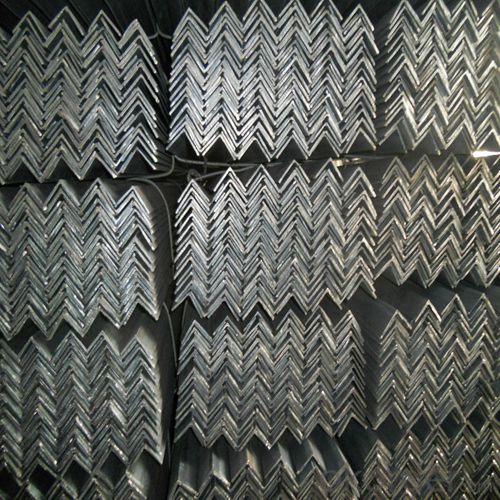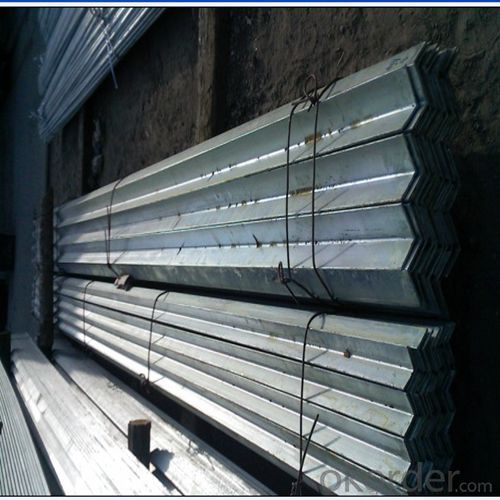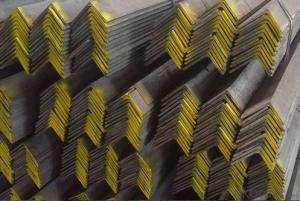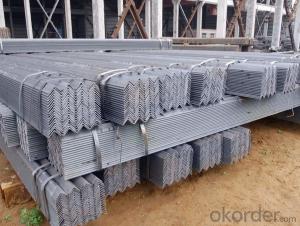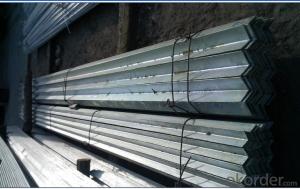Hot Rolled Steel Equal Angle Unequal Angle
- Loading Port:
- Tianjin
- Payment Terms:
- TT or LC
- Min Order Qty:
- 50 m.t.
- Supply Capability:
- 30000 m.t./month
OKorder Service Pledge
OKorder Financial Service
You Might Also Like
Product Description:
OKorder is offeringHot Rolled Steel Equal Angle Unequal Angle at great prices with worldwide shipping. Our supplier is a world-class manufacturer of steel, with our products utilized the world over. OKorder annually supplies products to European, North American and Asian markets. We provide quotations within 24 hours of receiving an inquiry and guarantee competitive prices.
Product Applications:
Hot Rolled Steel Equal Angle Unequal Angle are ideal for structural applications and are widely used in the construction of buildings and bridges, and the manufacturing, petrochemical, and transportation industries.
Product Advantages:
OKorder's Hot Rolled Steel Equal Angle Unequal Angle are durable, strong, and resist corrosion.
Main Product Features:
· Premium quality
· Prompt delivery & seaworthy packing (30 days after receiving deposit)
· Corrosion resistance
· Can be recycled and reused
· Mill test certification
· Professional Service
· Competitive pricing
Product Specifications:
Specifications of Angle Steel
1. Invoicing on theoretical weight or actual weight as customer request
2. Length: 6m, 9m, 12m as following table
3. Sizes

Sizes: 25mm-250mm | ||
a*t | ||
25*2.5-4.0 | 70*6.0-9.0 | 130*9.0-15 |
30*2.5-6.6 | 75*6.0-9.0 | 140*10-14 |
36*3.0-5.0 | 80*5.0-10 | 150*10-20 |
38*2.3-6.0 | 90*7.0-10 | 160*10-16 |
40*3.0-5.0 | 100*6.0-12 | 175*12-15 |
45*4.0-6.0 | 110*8.0-10 | 180*12-18 |
50*4.0-6.0 | 120*6.0-15 | 200*14-25 |
60*4.0-8.0 | 125*8.0-14 | 250*25 |
5. Payment terms:
1).100% irrevocable L/C at sight.
2).30% T/T prepaid and the balance against the copy of B/L.
3).30% T/T prepaid and the balance against L/C
6.Material details:
Alloy No | Grade | Element (%) | |||||
C | Mn | S | P | Si | |||
|
|
|
|
|
|
| |
Q235 | B | 0.12—0.20 | 0.3—0.7 | ≤0.045 | ≤0.045 | ≤0.3 | |
|
|
|
|
|
|
| |
Alloy No | Grade | Yielding strength point( Mpa) | |||||
Thickness (mm) | |||||||
≤16 | >16--40 | >40--60 | >60--100 | ||||
≥ | |||||||
|
|
|
|
|
| ||
Q235 | B | 235 | 225 | 215 | 205 | ||
Alloy No | Grade | Tensile strength (Mpa) | Elongation after fracture (%) | ||||
Thickness (mm) | |||||||
| ≤16 | >16--40 | >40--60 | >60--100 | |||
≥ | |||||||
|
|
|
|
|
|
| |
Q235 | B | 375--500 | 26 | 25 | 24 | 23 | |
Usage & Applications of Angle Steel
According to the needs of different structures, Angle can compose to different force support component, and also can be the connections between components. It is widely used in various building structures and engineering structures such as roof beams, bridges, transmission towers, hoisting machinery and transport machinery, ships, industrial furnaces, reaction tower, container frame and warehouse etc.
Packaging & Delivery of Angle Steel
1. Packing: it is nude packed in bundles by steel wire rod
2. Bundle weight: not more than 3.5MT for bulk vessel; less than 3 MT for container load
3. Marks:
Color marking: There will be color marking on both end of the bundle for the cargo delivered by bulk vessel. That makes it easily to distinguish at the destination port.
Tag mark: there will be tag mark tied up on the bundles. The information usually including supplier logo and name, product name, made in China, shipping marks and other information request by the customer.
If loading by container the marking is not needed, but we will prepare it as customer request.
Production flow of Angle Steel
Material prepare (billet) —heat up—rough rolling—precision rolling—cooling—packing—storage and transportation
FAQ:
Q1: Why buy Materials & Equipment from OKorder.com?
A1: All products offered byOKorder.com are carefully selected from China's most reliable manufacturing enterprises. Through its ISO certifications, OKorder.com adheres to the highest standards and a commitment to supply chain safety and customer satisfaction.
Q2: How do we guarantee the quality of our products?
A2: We have established an advanced quality management system which conducts strict quality tests at every step, from raw materials to the final product. At the same time, we provide extensive follow-up service assurances as required.
Q3: How soon can we receive the product after purchase?
A3: Within three days of placing an order, we will begin production. The specific shipping date is dependent upon international and government factors, but is typically 7 to 10 workdays.
Images:
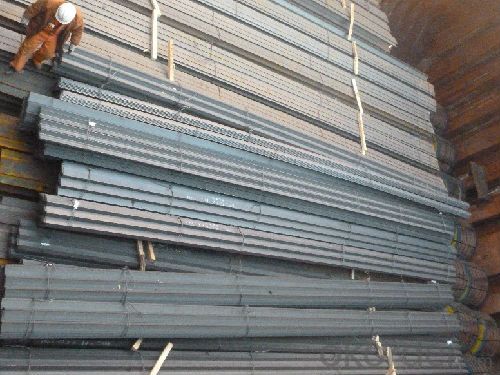

- Q: Can steel angles be used for architectural purposes?
- Certainly, steel angles can be utilized for architectural purposes. These versatile structural components find application in a myriad of architectural scenarios. Their primary function often involves providing crucial support and stability during building construction. For example, steel angles are employed as lintels or beams, effectively bearing the weight of walls, roofs, or floors. Furthermore, they serve as columns or braces, bolstering the overall structural integrity of a building. Moreover, steel angles can serve as decorative elements within architectural designs, imparting a contemporary and industrial aesthetic to the structure as a whole. Architects and engineers frequently opt for steel angles due to their robustness, resilience, and malleability when designing and erecting buildings.
- Q: How to determine the neutral axis of the angle bar?
- The neutral axis is a line which is the intersection of the neutral plane and the neutral axis corresponding to the strong axis of the cross section. The neutral axis is equal to the bisector of the sectional area parallel to the curved main axis, and the area on both sides of the neutral axis is equal, and the biaxial symmetry section is the centroid axis.
- Q: Are steel angles suitable for earthquake-resistant structures?
- Because of their high strength and ductility properties, steel angles are often used in earthquake-resistant structures. Their angular shape enables them to effectively withstand lateral forces resulting from seismic events. Steel angles have the capacity to absorb and disperse energy during earthquakes, making them suitable for withstanding the dynamic loads produced by ground movements. Moreover, connecting and joining steel angles is a straightforward process, which guarantees a high level of structural integrity and overall stability in buildings. These factors contribute to steel angles being a preferred option for earthquake-resistant structures, as they provide a dependable and long-lasting solution for minimizing the impact of seismic events.
- Q: Can steel angles be used for framing windows and doors?
- Absolutely! Framing windows and doors with steel angles is a fantastic option. In construction, these angles are widely favored due to their exceptional strength and durability. They establish a robust structure, guaranteeing ample support and stability for windows and doors. Moreover, steel angles possess remarkable resistance against warping, shrinking, and rotting, making them the perfect choice for any framing requirement.
- Q: What are the different types of steel angles connections for trusses?
- There are several types of steel angle connections commonly used for trusses, including gusset plate connections, bolted connections, welded connections, and clip angles.
- Q: Can steel angles be welded?
- Yes, steel angles can be welded. Welding is a commonly used method to join steel angles together. It involves heating the steel angles to a high temperature and then applying a filler material, usually in the form of a welding rod or wire, to create a strong bond between the angles. Welding provides a secure and durable connection between steel angles, making it suitable for various applications in construction, manufacturing, and other industries.
- Q: What are the different test methods used to evaluate steel angles?
- There are several test methods used to evaluate steel angles in order to ensure their quality and suitability for various applications. These test methods include: 1. Tensile Test: This test measures the tensile strength, yield strength, and elongation properties of the steel angles. It involves applying a gradually increasing load to a specimen until it reaches its breaking point, allowing for assessment of the material's ability to resist forces without deforming or breaking. 2. Bend Test: The bend test evaluates the flexibility and ductility of steel angles. A specimen is bent to a specific angle and assessed for any signs of cracking, fracture, or deformation. This test is crucial in determining the angles' ability to withstand bending forces without compromising their structural integrity. 3. Charpy Impact Test: This test measures the impact resistance and toughness of steel angles by subjecting a notched specimen to a high-velocity impact. The amount of energy absorbed during the impact is measured, indicating the material's ability to resist sudden loads or shocks. 4. Hardness Test: The hardness test determines the steel angle's resistance to indentation or scratching. Different methods such as Rockwell, Brinell, or Vickers hardness tests may be employed to evaluate the material's hardness properties, which can help assess its durability and wear resistance. 5. Ultrasonic Testing: Ultrasonic testing uses high-frequency sound waves to detect flaws or defects within the steel angles. This non-destructive test method allows for the identification of internal cracks, voids, or inclusions that may affect the material's structural integrity. 6. Dimensional Inspection: This test method involves measuring the dimensions, tolerances, and geometric properties of the steel angles. It ensures that the angles meet the required specifications and can provide accurate information for engineering calculations and fabrication processes. By utilizing these various test methods, manufacturers, engineers, and quality control personnel can assess the mechanical properties, structural integrity, and overall quality of steel angles, ensuring their suitability for specific applications.
- Q: Can steel angles be used for curtain walls?
- Yes, steel angles can be used for curtain walls. Steel angles are commonly used as structural elements in construction due to their strength and durability. When used in curtain walls, steel angles are typically used as frame members or mullions to support the glazing panels. They provide stability and rigidity to the curtain wall system, allowing it to withstand external forces such as wind loads and seismic activity. Additionally, steel angles can be customized to fit specific design requirements, making them a versatile choice for curtain wall applications.
- Q: How do steel angles perform in terms of electromagnetic shielding?
- Steel angles are known to be effective in terms of electromagnetic shielding. This is primarily due to their high electrical conductivity and magnetic permeability. These properties allow steel angles to effectively redirect or absorb electromagnetic waves, thereby reducing their impact on nearby electronic devices or sensitive equipment. The shape and geometry of steel angles also contribute to their shielding capabilities, as they can be strategically positioned to create barriers or enclosures that block or divert electromagnetic fields. Additionally, the thickness or gauge of the steel angle can further enhance its shielding performance. Overall, steel angles are widely used in various applications where electromagnetic interference needs to be minimized or controlled, such as in construction, telecommunications, electronics, and automotive industries.
- Q: Can steel angles be used for support brackets?
- Certainly, support brackets can indeed utilize steel angles. Given their strength and versatility, steel angles find widespread utility in construction and engineering contexts. Boasting a triangular configuration with symmetrical sides, these angles can be effortlessly affixed to walls, beams, or alternative structures, thereby offering essential support. Consequently, steel angles frequently serve as dependable brackets for sustaining substantial loads, providing stability, and bestowing durability upon the supported structure.
Send your message to us
Hot Rolled Steel Equal Angle Unequal Angle
- Loading Port:
- Tianjin
- Payment Terms:
- TT or LC
- Min Order Qty:
- 50 m.t.
- Supply Capability:
- 30000 m.t./month
OKorder Service Pledge
OKorder Financial Service
Similar products
Hot products
Hot Searches
Related keywords




